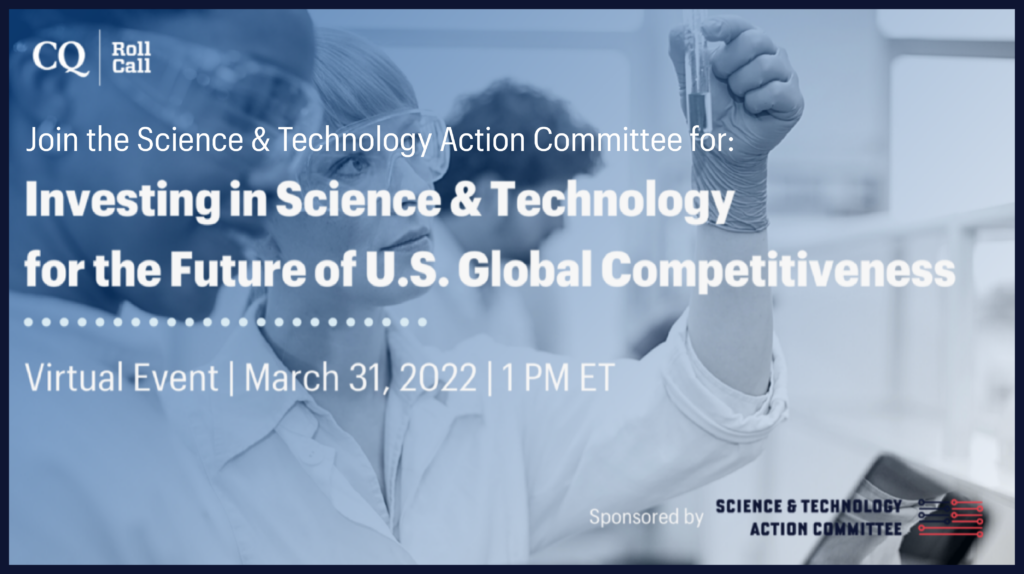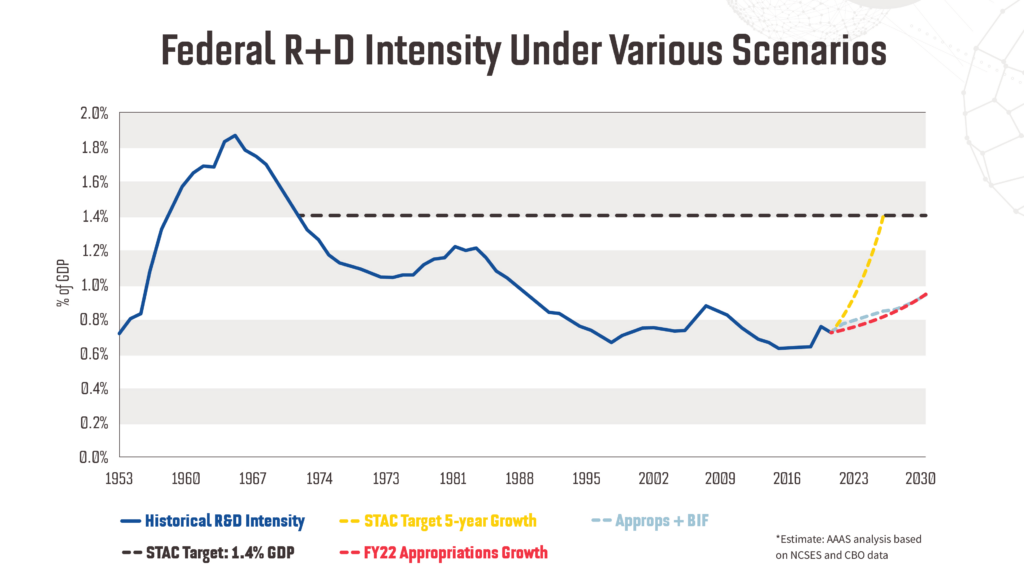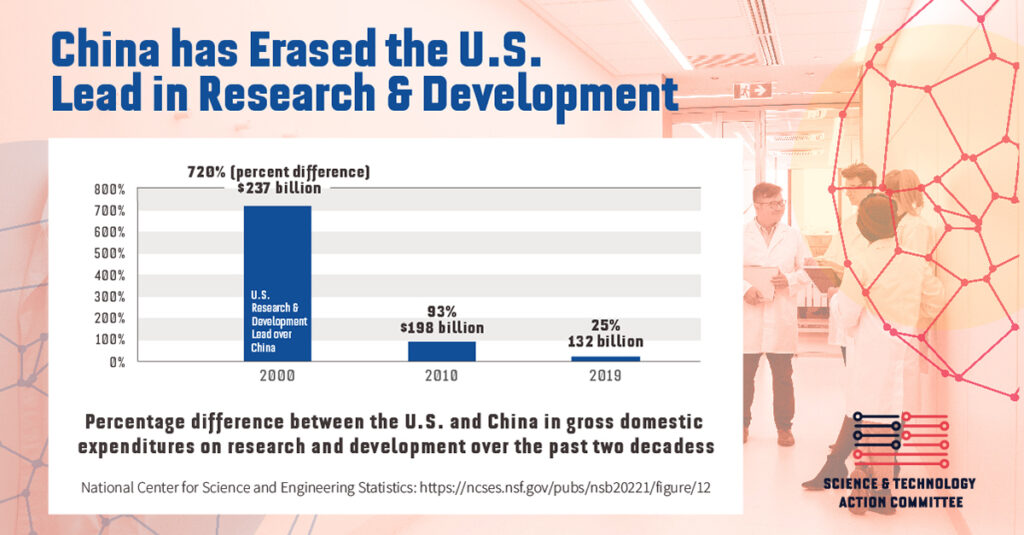What Congress does next could determine the future of U.S. global competitiveness
If a single year could provide a case study to illustrate the importance of science and technology to the United States, that year would be 2021.
The Covid-19 pandemic took hundreds of thousands of American lives and infected tens of millions more. Today, we’re rapidly approaching the 1 million death mark. Extreme weather events also wreaked havoc, with nearly two dozen individual billion-dollar natural disasters hitting the United States, killing more than 700 people and costing nearly $150 billion. Yet, even as these sobering statistics demonstrate an urgent need for more investment in science and technology, Congress has for years failed to sufficiently do so.

U.S. Science & Tech Investment is Less than Half its High-Water Point. In 1964, at the peak of the space race, federal spending on science and technology made up 1.9% of GDP. Today—even though technology is the fuel for our times, and we face existential threats such as climate change that science can help mitigate—it’s just 0.7%. We must rectify this underinvestment and reprioritize building the future this nation deserves.

For America to meet the challenges of the 21st century, the federal government must commit to increasing federal spending on research and development, finally breaking out of the cycles of neglect that have undermined our capabilities and imperiled our global competitiveness. This is not the time to outsource discovery and innovation—and the jobs that go with them—to other nations.
Consensus on Investment Emerges. The good news is that lawmakers on both sides of the aisle see the value of making these investments. Last year’s Infrastructure Investment and Jobs Act allocated $30 billion to fight climate change and $10 billion to strengthen STEM education and America’s future workforce. Additionally, the House and Senate are working toward finalizing a bipartisan bill that would inject billions of dollars in the science and technology enterprise aimed at investing in domestic research to enhance our global competitiveness.
China Narrows the U.S. Lead in Science and Tech Investment. Investing in science and technology today isn’t just about maintaining the status quo, but also keeping up with our global neighbors. While the U.S. rate of investment has limped along, it has surged in other countries. The share of global research and development spending performed by all institutions—all levels of government, higher education and businesses—in the U.S. declined from 29% in 2010 to 27% in 2019.
In contrast, China’s share increased from 15% to 22% during the same period. In fact, China is on track to overtake the U.S. in total R&D spending by 2030. An analysis from our organization, the Science and Technology Action Committee, found federal spending in these areas needs to at least double to 1.4% of GDP over the next five years to allow America to maintain its position as the world’s leader. Lawmakers now have an opportunity to begin to close that gap while simultaneously tackling the existential issues of our time—mitigating the effects of climate change, meeting growing energy needs, and preparing for the next pandemic, among other challenges. Investing now will also give America the lead in another vital mission: educating future generations of scientists.

Congress Has the Blueprint. The 2022 appropriations proposals include provisions that have already been carefully considered and enjoy bipartisan support. Additionally, the House and Senate competitiveness bills both have $52 billion in emergency spending to address the semiconductor shortage and enhance U.S. chips manufacturing. These bills also would create a Technology Directorate within the National Science Foundation (NSF), as well as increase funding for new and existing research awards, scholarships and fellowships. This would provide a much-needed boost for NSF, which funds nearly a third of basic research conducted at U.S. colleges and universities. Both bills call on the Office of Science and Technology Policy (OSTP) to develop an all-of-government strategy for advancing U.S. innovation, which in turn powers innovation and development by industry, creates jobs and drives prosperity.
Budget proposals from President Biden, the House and the Senate all include significant budget boosts for the National Institutes of Health, Centers for Disease Control and Prevention and Food and Drug Administration to prepare for and respond to the next pandemic. This funding would also establish the Advanced Research Projects Agency for Health, a new agency that expands the U.S. capability in biomedical research.
All of this will require the efforts of America’s best and brightest, yet we have a dearth of scientists in the pipeline. The Bureau of Labor Statistics forecasts that the U.S. will need an additional 1 million scientists in the coming decade. Critically, both competitiveness proposals call for just such an investment, including establishing new regional technology hubs and provisions that strengthen and broaden the STEM workforce. These investments in science and technology will be important for the health of our population, our planet and our economy. This is funding that will serve every American today and in the generations to come.
The Time to Invest in America’s Future is Now. At no time in recent history have we faced such a stark reminder of why we must continue to invest in science and technology. The swift creation of today’s mRNA vaccines—made possible by research funded and conducted over a period of decades—is a testament to the foresight past policymakers had by ensuring that reliable federal funding was in place to safeguard our nation’s future.
Decisions made years ago are paying dividends being realized today. It’s that simple. In order to solve tomorrow’s crises—and discover innovations we can’t yet imagine—we must reprioritize science and technology funding, and we must begin that work now.
Science and Technology Action Committee
(Professional affiliations are included for identification purposes only. The views expressed by the committee are not indicative of official positions of the organizations with which committee members are associated.)
Bill Novelli, Co-Chair
Professor, Georgetown University McDonough School of Business
Former CEO, AARP
Sudip Parikh, Co-Chair
CEO, AAAS
Mary Woolley, Co-Chair
President & CEO, Research!America
Keith R. Yamamoto, Co-Chair
Vice Chancellor for Science Policy & Strategy, UCSF
Georges C. Benjamin, MD, MACP
Executive Director
American Public Health Association
Bob Conn
Distinguished Policy Fellow & Pacific Leadership Fellow, Cowhey Center on Global Transformation
Michael M. Crow
President, Arizona State University
Dario Gil
Senior Vice President and Director, IBM Research
Harvey V. Fineberg
President, Gordon & Betty Moore Foundation
Margaret “Peggy” Hamburg
Former Commissioner, FDA
Kristina M. Johnson
President, The Ohio State University
Neal Lane
Senior Fellow in Science & Technology,
Rice University’s Baker Institute for Public Policy
Alan Leshner
CEO Emeritus, AAAS
Erin K. O’Shea
President, Howard Hughes Medical Institute
Jim Simons
Co-Chair, Simons Foundation
Rafael Reif
President, MIT
Elias Zerhouni
Former Director, NIH
This was originally sponsored content for CQ Roll Call
